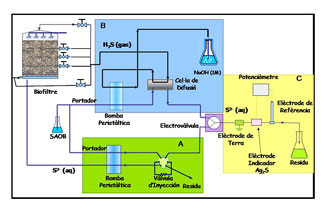New on-line analyser of harmful composes in biogas

Biogas production takes place in some biological processes where organic matter degradation occurs under anaerobic conditions. Simultaneously, high hydrogen sulfide concentrations (H2S) may be produced as well, which may contain between 500 and 20,000 ppmv (2% v/v) of H2S. A very interesting option of exploitation of biogas is to burn such biogas for the co-generation of energy. In this case, hydrogen sulfide presence supposes a series of disadvantages. The highly corrosive characteristics of H2S damage the equipment quickly. Moreover, during the combustion process harmful sulfur oxides (SO, SO2) are generated and released. These, together with the danger for the health that supposes to have H2S in industrial facilities are driving forces that justify the need of H2S removal from biogas before its use as a fuel.
Nowadays, H2S is the research target of many investigations, not only in terms of processes development for its removal, but also of systems of analysis for its determination and monitoring. The existing equipments for the analysis of H2S do not generally measure concentrations above 500ppmv and have a very short life-span. There are some commercial equipments with a detection range up to 10.000 ppmv, but these have very high prices and are not designed for their application in environmental processes destined to the treatment of biogas.
In the present work, the design and characterization of the analyser was based on the determination of sulfide (S2-) in the liquid phase (Figure 1 A) by the flow injection analysis technique (FIA), while the analysis of hydrogen sulfide in the gas phase (Figure 1 B) was performed by applying the continuous flow analysis technique with a previous gas diffusion step (GD-CFA). Both configurations are connected in parallel to a sole detection device for sulfide (Figure 1 C) formed by a silver sulfide electrode of crystalline membrane which is selective for ions. A tubular configuration that facilitates the application in the in-flow analytical system was chosen for the electrode. FIA and GD-CFA systems are generally simple, economic, fast and reliable. In this case, the equipment was designed for the in-line monitoring of a biological reactor destined to the desulfuration of biogas with high loads of hydrogen sulfide.
From the studies carried out in the optimization and characterization of the system, very satisfactory results have been obtained. Intervals of linear response have been achieved from 0,61 to 3.200 mg/L for S2- in the liquid and from 400 to 10.000 ppmv of H2S in the gas. These values are superior to these generally found in commercial devices and are in the intervals of concentrations typically found in biological reactors treating high loads of hydrogen sulfide. Moreover, the time per analysis was 60 seconds for liquid samples and less than 3 minutes in the case of gas samples, while the characteristics of the response are very suitable: high sensitivity, good repetitivity and high reproducibility in both systems.
Studies have been carried out with synthetic samples as well as with real samples. The results obtained have been identical. From the point of view of its application, the use of this automatic equipment in a biogas desulphurization facility allows obtaining information in a continuous way and, thus, to improve the process knowledge and to exert a better control on the desulfuration unit. All together may contribute to obtain better results of sulfide of hydrogen removal from biogas.
References
"On-line monitoring of gas-phase bioreactors for biogas treatment: hydrogen sulfide and sulfide analysis by automated flow systems". Rosa Redondo, Vinicius Cunha Machado, Mireia Baeza, Javier Lafuente, David Gabriel. ANALYTICAL AND BIOANALYTICAL CHEMISTRY. DOI. 10.1007/s00216-008-1891-5.


